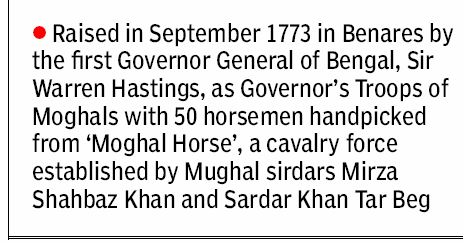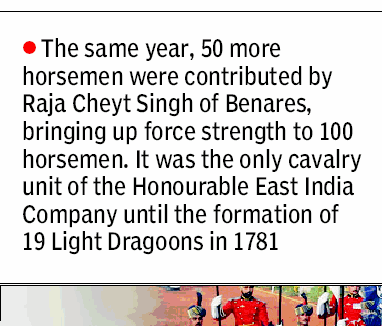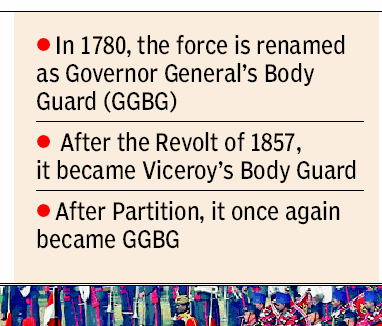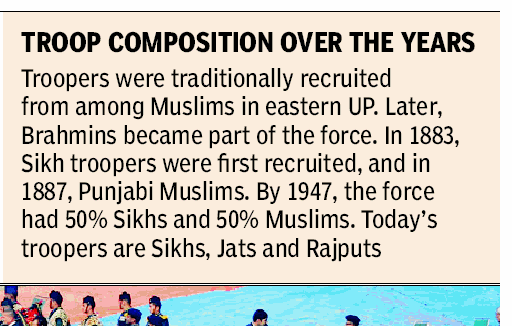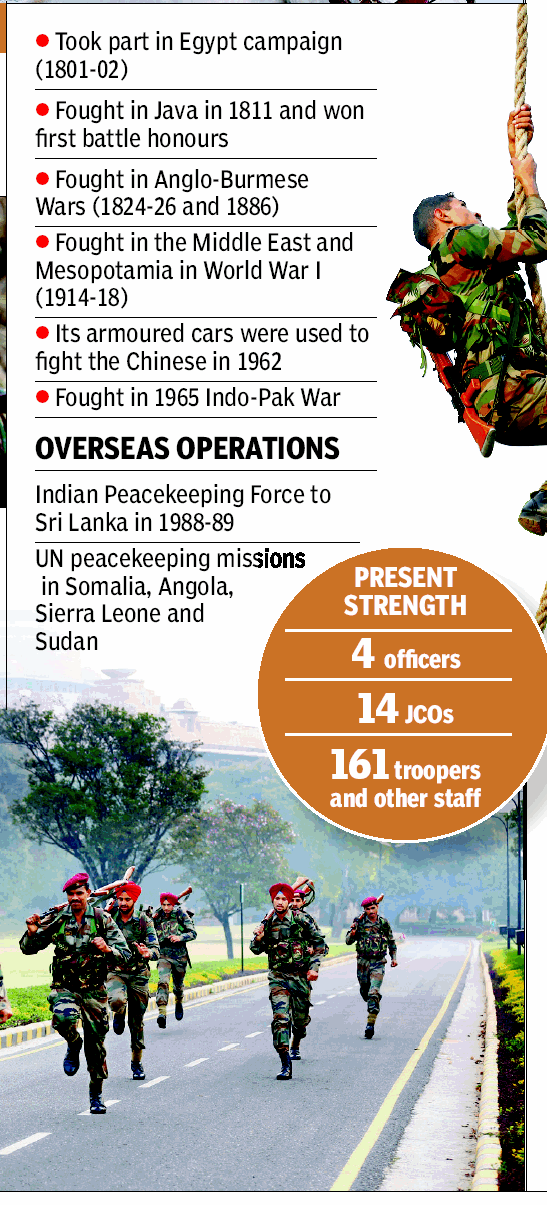The President’s Bodyguard (PBG)
Contents |
President’s Bodyguard (PBG): India
This is a collection of newspaper articles selected for the excellence of their content. |
All the President’s horsemen
Manimugdha S Sharma, TNN | Jun 23, 2013
Raised in A.D. 1773
Imagine yourself as a foot soldier in 17th century India standing on an open plain on a clear, sunny day with a light breeze kissing your face. It's a perfect setting for an author to pen a romantic tale, except that you are fighting a war and expecting the enemy. Suddenly, the ground beneath your feet trembles. An ominous dark cloud forms in the horizon and moves towards you with lightning pace; the terrifying noise that accompanies it makes you go numb with fear. Your heart skips a beat when the dust cloud breaks and 10,000 horsemen with sabres and lances burst forth. You stand no chance, for it's a Mughal heavy cavalry charge. Within seconds, this tidal wave would sweep past your line and there would be no trace left of you.
Cut to 2013, there are no Mughals or cavalry charges, but there's one force in India that can still do it the old way. With their bright livery, shining lances and sabres, and synchronised moves with well-trained horses, these men belong to one of the proudest regiments of the Indian Army—the President's Bodyguard (PBG). All of 240 years old, the PBG is the senior-most unit of the Army, raised in 1773 on the lines of the Household Cavalry Regiment of the British Army.
Cceremonial duties and combat too
The common man knows this elite household cavalry unit as the President's escort during the Republic Day parade and Beating the Retreat. "But we are much more than that. We are fighting men, not show jumpers. We have a lot of ceremonial duties, but our men have been in combat too. All our men are crack paratroopers and we send regular detachments to Siachen, UN peacekeeping operations and other theatres. All our officers come from mainstream armoured regiments of the Indian Army, handpicked by the President's Secretariat," says Colonel TS Mundi, commandant of PBG who has been leading the unit since 2011. He was deputed from 46 Armoured Regiment.
Lieutenant Colonel Amit Bhardwaj is the Second-in-Command or the '2IC' of the regiment. "I am also the unit's adjutant. I came here a year ago from 52 Armoured Regiment, my parent unit, so I'm very much a tank man. Only officers of the armoured units can be the commandant and 2IC of PBG," Bhardwaj says. He recently got promoted, and TOI caught him in transition from being a major to wearing an additional star on his epaulettes. Behind him on the wall is a huge board that has the names and service years of his predecessors. "Why isn't your name on the board," we ask. "Well, I will add it at some point in the future," he says, with a disarming smile.
'Colonel of the Regiment'
Every Indian Army regiment has a 'Colonel of the Regiment'. In case of PBG, it is Major General Anil Khosla SM, VSM, who is also the Military Secretary to the President (MSP). Under the stewardship of the Secretary to the President, the Secretariat has taken the initiative to revive old and rich traditions of PBG. What are those traditions? "There are many. But before, the President used to tour the estate in his buggy. Due to security reasons, the limousine replaced it. Now, he is going to tour the estate in his buggy again. But only his estate. He will use the limousine when he goes out of Raisina Hill," says Bhardwaj.
Administrative structure
PBG has four officers, 14 JCOs (junior commissioned officers) and 161 troopers supported by administrative staff. But to be eligible for this "most prestigious posting" in their careers, the men must meet exacting physical and mental standards. For the troopers, the minimum height is six feet. Although good looks are not a requirement, TOI found all the officers and men—whom we met over the two weeks of our research—strikingly handsome. During the Raj, the English had de-abbreviated GGBG (then Governor General's Bodyguard) as 'God's Gift to Beautiful Girls'.
At over six feet, Naib Risaldar Vijender Singh towers over this correspondent. "In the cavalry, we don't have Subedars but Risaldars. I have spent 25 years in this elite unit. The JCO right above me is the Risaldar Major. I was recruited here and will retire from here. And there have been a few men in the past who followed their fathers and grandfathers to this unit," Singh says as he takes TOI to the Quarter Guard and then the stables.
The PBG has 86 horses—mostly half-bred—of which 6 are Hanoverians (or English horses). Four of these draw the President's buggy, while the others serve as mounts of the CO and the 2IC. "Most of our horses are bay in colour and are required to be of a minimum height of 157.5cm measured at the shoulder. The horses are bred at the Army's Remount and Veterinary Corps depots. We try to get them when they are about three years old so that they can absorb the training more. We have to make them used to sounds of gunfire, honking of cars, and lots of other things. They can trot, canter and gallop and are trained for cavalry charges, too, even though we won't possibly ever need one today," says Colonel Mundi.
Uniforms and firearms
The PBG is the only regiment of the Indian Army that wears bright red coats and white breeches—the standard uniform of the British Army until the adoption of khakis. But that's their winter uniform; in summers, the ceremonial uniform is all white. Their normal uniform is the standard Indian Army olive green, but they wear maroon berets. The standard firearms issued to the force is the INSAS 5.56mm rifle; the sidearm is either the Auto 9mm 1A pistol (a licensed copy of Canadian Inglis) or 9mm Beretta. And they are adept at handling these weapons. Nevertheless, the security of the President is not their brief but of Delhi Police.
Eco-conscious
But beyond its ceremonial duties, PBG is leading a green charge. "We are doing our bit to save the environment. We have done several plantations at our parade ground and at PBG's estate in Dehradun named Aashiana, which has also served as the President's retreat in the past. We have also set up a biogas plant for green energy and are about to make functional another plant where we will generate energy with horse dung alone," says Bhardwaj.
The President's horsemen are marching on to a new, green age in style.
